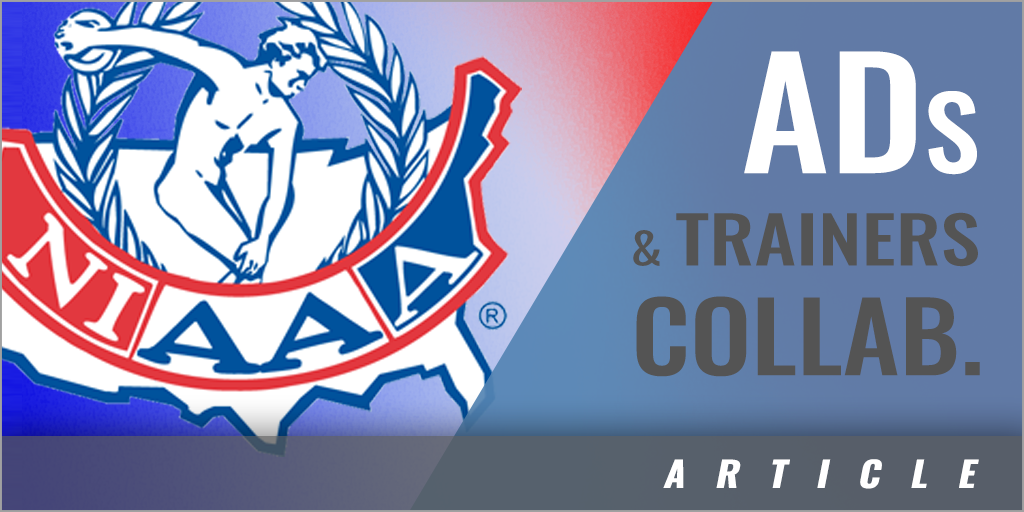|
By: Dr. Kechia Rowles, CMAA Not the Only Pegasus Although dual roles in athletic administration are not uncommon, I unassumingly thought that my dual role position was "mythical." You see, I perceived my journey into interscholastic athletic administration to be unique until an emergency ensued at the 50th National Athletic Directors Conference in National Harbor, Maryland. Several athletic administrators/athletic trainers responded, and I felt a sense of affiliation. I was certain they were like-minded dual credentialed individuals, like myself, who clearly understood the importance of the athletic trainer in middle and high school athletics. I was hired as the districts' first Athletic Coordinator/Athletic Trainer, a position that was created out of necessity after the death of a student-athlete. As the only athletic trainer (AT) for the district with seven athletic programs, the fictitious concept of "work-life" balance was not my reality. From multiple event coverage conflicts to missed family gathering, it was a challenge to execute both positions with efficiency while carrying a sense of guilt for the inevitable emergency if I wasn't present. Over the years, I transitioned out the dual role and hired additional ATs to provide care for our district athletic programs; however, I vividly recalled the long days and feelings of being underappreciated as an AT. In my district leadership role, I am committed to setting expectations for school-level athletic administrators to be inclusive of the AT as part of the athletic staff. I want to find ways to respect the AT as a person and not as a position to aid in sustaining optimal department efficiency. The Athletic Trainer Defined While your coaches game plan daily for upcoming competitions, your AT also prepares daily to ensure student athletes are healthy to return to play. Your AT carries the burden of delivering bad news regarding an injury, endures long hours and oftentimes feels isolated, which can be taxing physically, mentally, and emotionally. Most likely, outside of you (athletic administrator), your AT is the only person in your athletics department who has a personal relationship with all your competitive programs. However, your AT provides both services and support to your department. The ATs contributions include:
Every Athlete Deserves an Athletic Trainer According to the 2020-21 Athletic Training Locations and Services (ATLAS) Project, 54% of public and private high schools received athletic trainer services. The importance of having an AT was magnified as athletic programs around the world navigated through the COVID-19 pandemic, when they assisted in designing mitigation strategies, conducted pre-screenings, and assisted with contact tracing. It's a personal initiative for me in my district to ensure we have safety measures in place and accessible medical care to prevent another tragedy. If your school doesn't have AT services, understand that ATs are not a luxury, they are a necessity. Despite the geographic proximity of an area medical facility or the socioeconomic status of your school's community, student athletes deserve the same efforts in protecting them as is given in promoting them. If you've already identified obstacles that would limit your ability to hire an AT, you are not alone. According to Mazerolle, Raso, Pagnotta, Stearns, and Casa (2015) several factors were identified as barriers of hiring ATs in high schools. The article stated that athletic directors felt they lacked the power to hire an AT as it was perceived to be the responsibility of the superintendent and the school board. Budget concerns pertaining to funding allocated to specific resources within the school did not include an AT was also mentioned. Lastly, misconceptions about the role of an AT led to the belief that first-aid trained coaches were appropriate medical providers and community support from local clinics, hospitals, and volunteers was adequate. Supporting your Athletic Trainer Athletic administrators must support the AT to promote a strong working relationship. Here are some suggestions and examples of fostering an inclusive department with your AT and establishing boundaries to prevent burnout.
ATs are an important member of your department. While most of the AT's contributions won't make the sports page, the AT is a highly qualified, skilled healthcare provider that takes pride in ensuring that athletes take proactive measures to prevent injuries and are physically and mentally prepared to return to play post-injury. The first step in fostering an inclusive environment is to garner a sense of belonging for the AT and validate their efforts to provide a safe athletic experience. References: Mazerolle SM, Raso SR, Pagnotta KD, Stearns RL, Casa DJ. Athletic Directors' Barriers to Hiring Athletic Trainers in High Schools. J Athl Train. 2015 Oct;50(10):1059-68. ABOUT THE AUTHOR: Dr. Kechia Rowles, CMAA, is the director of athletics for Rockdale County Public Schools in Conyers, Georgia. She can be reached at krowles@rockdale.k12.ga.us. |






